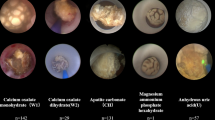Abstract
The grading of gemstones is currently a manual procedure performed by gemologists. A popular approach uses reference stones, where those are visually inspected by specialists that decide which one of the available reference stone is the most similar to the inspected stone. This procedure is very subjective as different specialists may end up with different grading choices. This work proposes a complete framework that entails the image acquisition and goes up to the final stone categorization. The proposal is able to automate the entire process apart from including the stone in the created chamber for the image acquisition. It discards the subjective decisions made by specialists. This is the first work to propose a machine learning approach coupled with image processing techniques for emerald grading. The proposed framework achieves 98% of accuracy (correctly categorized stones), outperforming a deep learning approach. Furthermore, we also create and publish the used dataset that contains 192 images of emerald stones along with their extracted and pre-processed features.










Similar content being viewed by others
References
Alsabti K, Ranka S, Singh V (1997) An efficient k-means clustering algorithm. Electr Eng Comput Sci 43:1997. https://surface.syr.edu/eecs/43/
Breiman L (2001) Random forests. Mach Learn 45:5–32
Cha SH, Srihari SN (2002) On measuring the distance between histograms. Pattern Recognit 35:1355–1370
Chen M, Han J, Yu P (2005) Data mining: an overview from a database perspective. IEEE Trans Knowl Data Eng 8:866–883
Clark D (2019) A consumer’s guide to gem grading. https://www.gemsociety.org/article/a-consumers-guide-to-gem-grading/
Crabi D et al. (2020). https://github.com/DaniloRicardoCrabi/Emeralds-.git
Dominguez-Lopez JA, Damper RI, Crowder RM, Harris CJ (2004) Adaptive neurofuzzy control of a robotic gripper with on-line machine learning. Robot Auton Syst 48:93–110
Dubuisson S (2010) The computation of the Bhattacharyya distance between histograms without histograms. In: International conference on image processing theory, tools and applications
FMI (2018). https://www.futuremarketinsights.com/press-release/650
Frank E, Hall MA, Witten IH (2016) Data mining: practical machine learning tools and techniques. IEEE J Biomed Health. Inform 5(51):2006. https://biomedical-engineering-online.biomedcentral.com/articles/10.1186/1475-925X-5-51:
Geology (2018). https://geology.com/gemstones/emerald/
Geurts P, Ernst D, Wehenkel L (2006) Extremely randomized trees. Mach Learn 63:3–42
Giuliani G, Groat LA, Marshall D, Fallick AE, Branquet Y (2019) Emerald deposits: a review and enhanced classification. Minerals 9:105
Hall M, Frank E, Holmes G, Pfahringer B, Reutemann P, Witten IH (2009) The weka data mining software: an update. SIGKDD Explor 11:10–18
Hastie T, Tibshirani R, Friedman J (2009) The elements of statistical learning. Data Mining, Inference, and Prediction. pp 485–585. https://doi.org/10.1007/978-0-387-84858-7
Instituto Gemológico da América (2019). Emerald quality factors. https://www.gia.edu/emerald-quality-factor
Krizhevsky A, Sutskever I, Hinton GE (2017) Imagenet classification with deep convolutional neural networks. Commun ACM 60:84–90
Manson DV, Stockton CM (1982) Gem-quality grossular garnets. Gems Gemol 18:204–213
McClure SF, Moses TM, Tannous M, Koivula JI (1999) Classifying emerald clarity enhancement at the gia gemtrade laboratory. Gems Gemol 35:176–185
Messelodi S, Modena CM, Zanin M (2005) A computer vision system for the detection and classification of vehicles at urban road intersections. Pattern Anal Appl 8:17–31
Rodrigues E, Conci A, Liatsis P (2020a) Element: multi-modal retinal vessel segmentation based on a coupled region growing and machine learning approach. IEEE J Biomed Health Inf 24:3507–3519
Rodrigues EO (2018) Combining minkowski and chebyshev: New distance proposal and survey of distance metrics using k-nearest neighbours classifier. Pattern Recognit Lett 110:66–71
Rodrigues EO, Casanova D, Teixeira M, Pegorini V, Favarim F, Clua E, Conci A, Liatsis P (2020) Proposal and study of statistical features for string similarity computation and classification. Int J Data Min, Modell Manag 12:277–307
Rodrigues EO, Conci A, Liatsis P (2018) Morphological classifiers. Pattern Recognit 84:82–96
Rodrigues EO, Morais FFC, Morais NAOS, Conci LS, Neto LV, Conci A (2016) A novel approach for the automated segmentation and volume quantification of cardiac fats on computed tomography. Comput Methods Progr Biomed 123:109–128
Rodrigues EO, Torok L, Liatsis P, Viterbo J, Conci A (2017) k-MS: a novel clustering algorithm based on morphological reconstruction. Pattern Recognit 66:392–403
Silva LF, Santos AASMD, Bravoc RS, Silva AC, Muchaluat-Saade DC, Conci A (2016) Hybrid analysis for indicating patients with breast cancer using temperature time series. Comput Methods Progr Biomed 130:142–153
Sinkevicius S, Lipnickas A, Rimkus K (2015) Automatic amber gemstones identification by color and shape visual properties. Eng Appl Artif Intell 37:258–267
Stockton CM, Manson DV (1985) A proposed new classification for gem-quality garnets. Gems Gemol 21:205–218
Tang J, Deng C, Huang G (2016) Extreme learning machine for multilayer perceptron. IEEE Trans Neural Netw Learn Syst 27:809–821
Wang D, Bischof L, Lagerstrom R, Hilsenstein V, Hornabrook A, Hornabrook G (2016) Automated opal grading by imaging and statistical learning. IEEE Trans Syst Man Cybern Syst 46:185–201
Wang K, Zhang J, Li D, Zhang X, Guo T (2007) Adaptive affinity propagation clustering. Acta Autom Sin 33:1242–1246
X-rite (2019) Factors affecting how we see color. https://www.xrite.com/page/factors-affecting-how-we-see-color
Author information
Authors and Affiliations
Corresponding author
Additional information
Publisher's Note
Springer Nature remains neutral with regard to jurisdictional claims in published maps and institutional affiliations.
Rights and permissions
About this article
Cite this article
Pena, F.B., Crabi, D., Izidoro, S.C. et al. Machine learning applied to emerald gemstone grading: framework proposal and creation of a public dataset. Pattern Anal Applic 25, 241–251 (2022). https://doi.org/10.1007/s10044-021-01041-4
Received:
Accepted:
Published:
Issue Date:
DOI: https://doi.org/10.1007/s10044-021-01041-4




